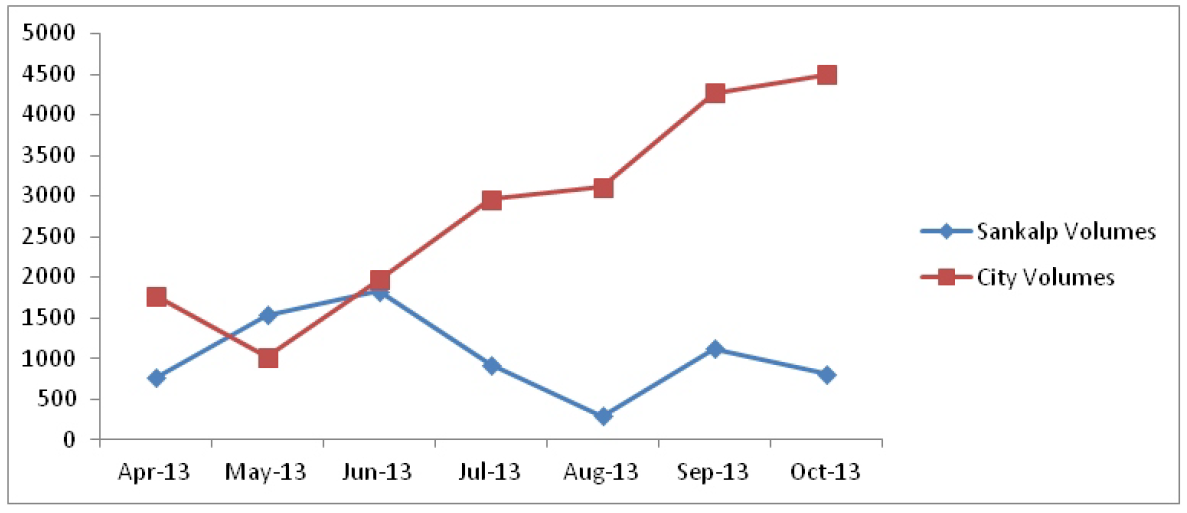Dr Prasanna, the Blood Bank Medical Officer of Victoria Hospital, Bangalore had a hard time in the last week of October. As many as 5 different individuals/organizations wanted to organize a blood donation drive on 1 November - the day of Kannada Rajyotsava. The Medical Officer says that despite him requesting some of them to reschedule the drives to a later date; none were even considering it. Emotions related to the day ran high. Eventually the blood bank agreed to do one drive and informed the others that they were currently too busy and sufficiently stocked!. There are times of the year when the same blood bank has too few units on the shelf.
The situation at Victoria Hospital Blood Bank is just an example. Perhaps many more blood banks will narrate almost similar stories. To substantiate this, here are some more situations that came up at different times of the year.
- IGICH (Indira Gandhi Institute of Child Health) Blood Bank has reported twice in the last 15 days ) on the Blood Helpline) that they are having an excess platelet stock. They requested that anyone looking for platelets be redirected to their blood bank.
- Mr Sundar K S, the coordinator for blood donation drives at Rashtrothan Blood Bank has written to Sankalp that they have a massive blood stock and that they not be invited for any blood donation drive till the end of November.
- There have been atleast 3 instances in the last 20 days when blood banks have backed off from blood donation drives with just 1 or 2 days remaining leaving camp organizers in a fix.
- During the months of April, May certain blood banks from the city have collected blood in blood donation drives organized in different districts. At these times, blood banks have agreed for drives where even 20 units of blood are expected to be collected!
- Again during summer months most blood banks had split teams heading towards different blood donation drives. Staff and resources were stretched beyond limits to ensure adequate stock of blood.
Sankalp India Foundation has been working with the blood banking community on various fronts since 2003. Year after year, a similar pattern of overload and shortage unfolds itself. In this article we go a little further in analyzing the dynamics of these variations. Although the story maybe similar at most places, here we limit the scope of our analysis to Bangalore city.
Factors that contribute to this skewed availability.
 A fluctuation in availability of blood in Bangalore city is not new. The primary factors that contribute to this trend are
A fluctuation in availability of blood in Bangalore city is not new. The primary factors that contribute to this trend are
- Voluntary Blood Donation Drives in Colleges: It has been clearly established that students are the biggest source of voluntarily donated blood. There are 70+ Engineering and 100+ other colleges established in and around the city and most of these institutions choose the second half of the year for an annual blood donation drive. Consequently in the period from August - October there is a huge overload of blood (mostly RBC) in most blood banks. Most colleges are averse to the idea of a 2nd drive during the summer months. This simply implies that the supply of safe blood to blood banks is badly affected when students are busy with examinations or go for vacations.
- Drives on special days: Like indicated before there are some days in the calendar year when simply too many individuals or organizations want to organize a blood donation drive. November 1, August 15, October 2, January 26 are classic examples. Many corporate organizations too are keen on blood donation drives during Oct 2 - 8 (The Joy Of Giving Week). Such practices cause a severe imbalance in the blood scenario of the city. June 14 and Oct 1 are also favorites with some institutions.
- Seasonal Blood Requests: Some seasonal diseases wreck havoc. Dengue is one of them and perhaps the most problematic for the blood banking community. During the months of May - July, Dengue literally eats up almost all the platelets in the city. With the cost of SDP being almost unaffordable in most of the hospitals in the city, people are left with the arduous task of arranging for many units of RDP. Sometimes it gets very hard to find a single unit of platelets.
Sankalp’s Experience and Work on Creating a Sense of Balance
Sankalp India Foundation has been organizing blood donation drives since March 2007. Initially the organization’s focus was to organize as many quality blood donation drives as possible. However, in the last 2-3 years blood availability trends have clearly influenced the timing and number of drives.
Take for instance the case of summer months in 2013 when most blood banks in the city where running dry. Sankalp organized more than 35 blood donation drives during this period resulting in a collection of 5000 units from April to July 2013. Once the load was higher in the city the number of drives was limited drastically resulting in a collection of 2224 units from August to October 2013.
Here is a comparison of Sankalp’s collection versus the volume of blood available in the city for these months

Sankalp volumes: Units of blood collected by Sankalp in Bangalore
City Volumes: Average of the blood stocks of RBC+WB reported in Bangalore on Sankalp's Statewide helpline for blood
It shows that Sankalp has been successful in ensuring that more donations happen in the lean period compared to the other times in the year. Careful and meticulous planning has helped the organization create this sense of balance and impact. Experience of previous years has come in handy. Many organizations now rely on Sankalp for scheduling of their blood donation drives.
Steps towards Regularizing Blood Supply
 It is now time to take steps towards effective blood banking that ensures an optimum supply of blood throughout the year. In most cases it is about engaging in elaborate conversations with organizations to educate them. Some practices that will help in this direction include. (Many of these practices have been adopted by Sankalp and are helping us in our efforts to create a sense of balance.)
It is now time to take steps towards effective blood banking that ensures an optimum supply of blood throughout the year. In most cases it is about engaging in elaborate conversations with organizations to educate them. Some practices that will help in this direction include. (Many of these practices have been adopted by Sankalp and are helping us in our efforts to create a sense of balance.)
- Planning Legacy Drives Only During Peak Summer and Winter: In many cases blood banks have been working with some organizations for blood donation drives for many years. In majority of such cases it is seen that blood banks agree to camps from these organizations when the organization vouches for the same so that cordial relationships are not disturbed. A little bit of effort in educating these organizations to help the overall supply of blood will create a significant difference.
- Pushing organizations for Bi-Annual Blood Donation Drives: Most organizations (particularly educational institutions) tend to look at blood donation as a yearly activity. Making such organizations aware of the need for blood throughout the year will be a first step in encouraging them to organize 2 blood donation drives (spaced at an interval of 6 months) during peak shortage times. Although this will take time to stabilize, once the practice is put in place and the benefit to the community is depicted, organizations will willingly oblige.
- Avoiding Too Many Drives On Special Occasions: In his efforts to encourage some organizers to postpone drives, the Blood Bank Medical Officer of Victoria Hospital Blood Bank indicated that Rajyotsava is not just on Nov1, but the entire month of November is considered as a festive season. Similarly efforts were put in to enlighten some organizations that instead of a Joy Of Giving Week, A Joy Of Giving Month can be celebrated thereby avoiding overload of blood in a particular week and spacing them all through the month. Using similar arguments too many blood donation drives on particular days can be avoided and rather spaced out in an interval of few days
- In House Blood Donation Drives During Peak Shortage: There are a few organizations where infrastructure and space come in the way of organizing blood donation drives. In such cases it is best to keep such organizations on hold and organize an in house blood donation drive during peak shortage. A little bit of encouragement is required. With this organizers usually oblige. All organizations ask for in this case is help in transportation of donors and specific time slots for donations – both of which are quite immaterial considering the need.
- Timely Transportation Of Blood To Other Safe Blood Banks: Although exchange of blood and blood bags is happening across the state, there is not much of clarity on when and where blood units are moved. Also, blood units tend to be moved when the expiry of the unit is in sight. Using trends and statistics gathered from Sankalp’s Blood Helpline and the Drug Controller’s website where blood stocks are recorded daily, blood banks can plan effective movement of blood to regions where the need is more. Since anyways some blood banks are aware of the estimates they are expected to collect, it may be a good idea to move blood early thus ensuring most effective utilization
The situation is much clearer now. With trends and statistics of availability clearly indicating periods of overload and shortage, it is time for the blood banking fraternity to make an informed choice – to make rigorous plans towards effective utilization or be ignorant towards reality of the need and usage of precious units of blood!
